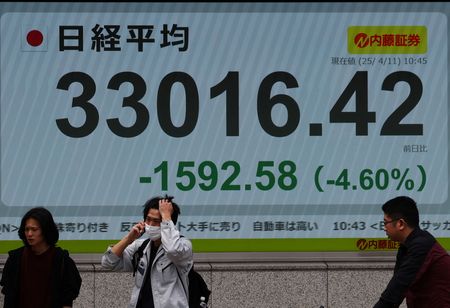By Caroline Valetkevitch
NEW YORK (Reuters) -Benchmark 10-year U.S. Treasury yields registered their biggest weekly rise in more than two decades on Friday, while the dollar fell, in a turbulent week marked by the trade war and a loss of appetite for some U.S. assets.
Gold prices hit another record high on Friday after Beijing increased its tariffs on U.S. imports to 125%, hitting back against U.S. President Donald Trump’s decision to hike duties on Chinese goods.
Global markets have been hit by wild swings this week as investors reacted to news following Trump’s announcement of sweeping tariffs on April 2.
Even so, major U.S. stock indexes rose more than 1% on the day as banks kicked off the first-quarter earnings season. Also helping stocks were assurances from Boston Federal Reserve President Susan Collins that the Fed is prepared to keep financial markets functioning should the need arise. All three major U.S. indexes also rose sharply for the week.
Ten-year Treasury yields jumped this week, with trading volumes well above average, amid fears that China may be offloading a large portion of its U.S. bond holdings after the announcement of U.S. tariffs.
“Trump continues to dominate the headlines and the financial markets, especially as we get into this period of negotiating tariffs,” said Tim Ghriskey, senior portfolio strategist at Ingalls & Snyder in New York.
“There will be lots of rumors and posturing,” he said.
Strong auctions of 10-year and 30-year debt on Wednesday and Thursday helped stabilize the Treasury market somewhat, but many investors remain wary of buying bonds until there is further improvement in liquidity.
The 10-year note yield was last up 8.6 basis points on the day at 4.478% and reached 4.592%, the highest since February 13. It posted its largest weekly increase since 2001.
Concerns over U.S. trade policy made euro-denominated assets appear safer than their dollar counterparts. The German 10-year bond yield, the benchmark for the euro zone bloc, eased 5 bps to 2.53% on Friday.
JPMorgan Chase, Morgan Stanley and Wells Fargo were among the big banks to report earnings, which mostly showed they beat forecasts for the first quarter. JPMorgan shares rose 4%.
With the trade war hanging over the outlook, investors will be watching to see whether U.S. companies continue to offer guidance during the earnings period.
The Dow Jones Industrial Average rose 619.05 points, or 1.56%, to 40,212.71, the S&P 500 rose 95.31 points, or 1.81%, to 5,363.36 and the Nasdaq Composite rose 337.15 points, or 2.06%, to 16,724.46.
The Nasdaq registered its biggest weekly percentage gain since November 2022.
MSCI’s gauge of stocks across the globe rose 11.36 points, or 1.46%, to 790.63. he pan-European STOXX 600 index ended down 0.1%.
Investors also digested a report showing U.S. consumer sentiment deteriorated sharply in April and another showing U.S. monthly producer prices unexpectedly fell in March.
The dollar was down 0.9% at 0.81650 against the Swiss franc, extending losses in the previous session when it plunged to its lowest level since January 2015. It is on track for its biggest weekly drop since November 2022.
The dollar also hit a three-year low versus the euro .
Spot gold was up 2% at $3,236.67 an ounce, after hitting a record high of $3,243.82 earlier in the session. Bullion is up over 6% this week.
Oil prices also climbed. Brent crude futures settled at $64.76 a barrel, up $1.43, or 2.26%. U.S. West Texas Intermediate crude finished at $61.50 a barrel, up $1.43 or 2.38%.
(Reporting by Caroline Valetkevitch; additional reporting by Amanda Cooper in London; Editing by Nia Williams, Rod Nickel and Cynthia Osterman)












